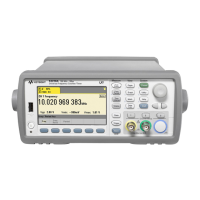53220A/53230A Measurements 3
Keysight 53220A/53230A User’s Guide 113
The commands used to make positive and negative duty cycle measurements are:
MEASure:PDUTycycle? [{<reference>|MINimum|MAXimum| DEFault}]
[,<channel>]
CONFigure:PDUTycycle [{<reference>|MINimum|MAXimum| DEFault}]
[,<channel>]
MEASure:NDUTycycle? [{<reference>|MINimum|MAXimum| DEFault}]
[,<channel>]
CONFigure:NDUTycycle [{<reference>|MINimum|MAXimum| DEFault}]
[,<channel>]
– reference specifies the threshold level where the duty cycle measurement
begins. For positive duty cycle measurements, the level at which the signal
passes through the threshold in the positive (rising) direction and again in the
negative (falling direction) defines the positive duty cycle. Similarly, the level at
which the signal passes through the threshold in the negative (falling) direction
and again in the positive (rising) direction defines the negative duty cycle.
To specify a threshold level from 10% to 90% of the peak-to-peak input voltage,
use a numeric value with no suffix or with the suffix PCT (e.g. 30 or 30 PCT).
To specify a threshold level in absolute voltage within the ranges:
5.125V range: -5.125V to +5.125V
51.25V range: -51.25V to +51.25V
use a numeric value with the V or MV (millivolt) suffix: 100 MV or .1V (spaces
allowed).
If reference is omitted or specified in percent, auto-leveling is enabled. If
specified in absolute voltage, auto-leveling is disabled
– channel is counter channel 1 or 2 specified as (@1) or (@2).
Positive and negative duty cycle measurement examples
// using MEASure? - measure the positive duty cycle at a
// 50% (0V) reference
*RST // reset to start from known state
MEAS:PDUT? 50, (@1)
// using CONFigure - measure the positive duty cycle at a
// -1.0V reference

